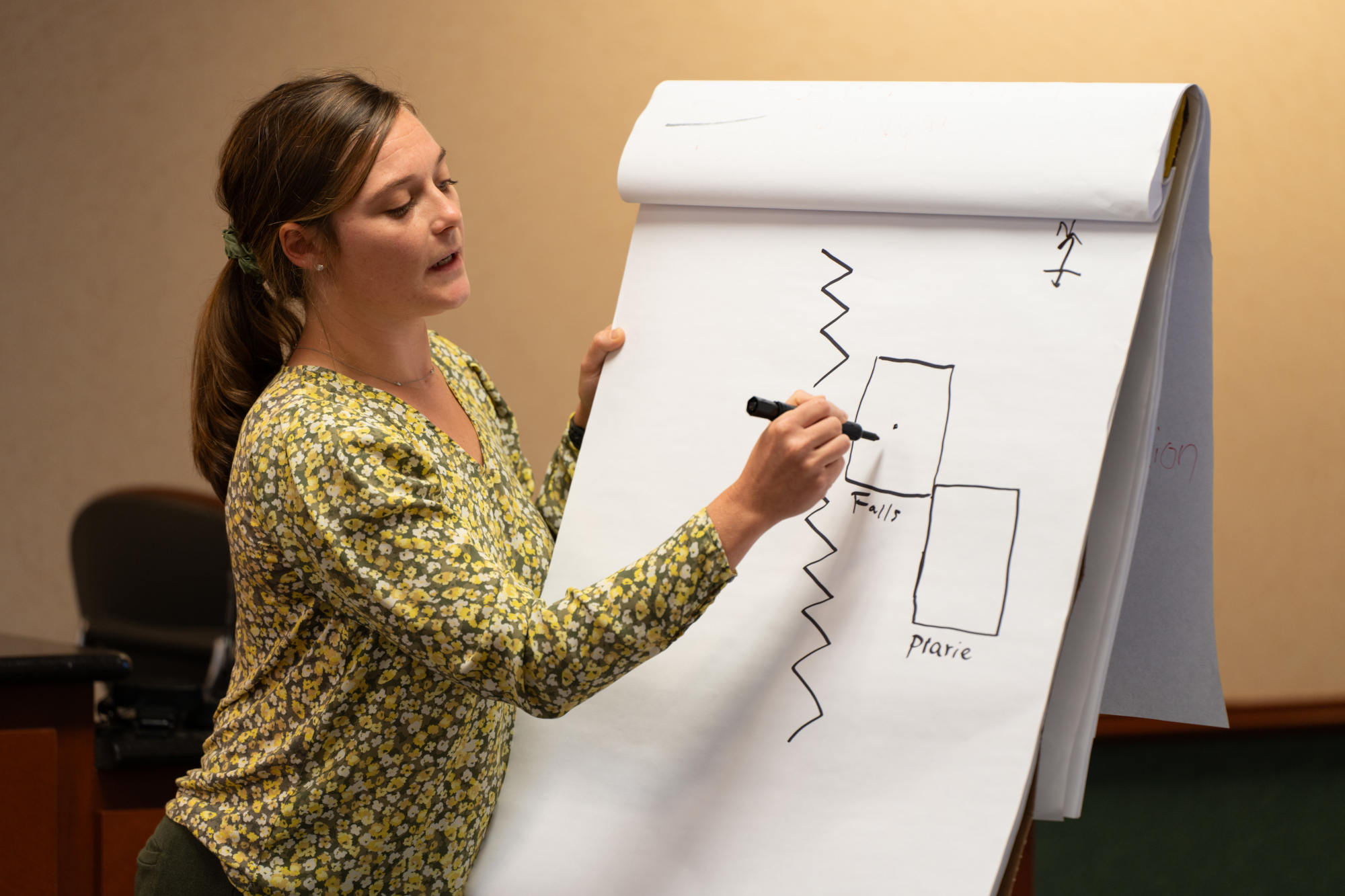
A Minnesota mock courtroom lays bare one of the thorniest issues confronting climate litigation: scientific evidence.
On the morning of July 27, 2023, during a heat wave in one of the hottest summers in recorded history, two oscillating fans pushed the air around a courtroom in St. Paul, Minnesota, as Judge Nicole Starr called a pretrial hearing to order. Like many civil cases that failed to settle before trial, the two opposing sides had prepared opposing expert witnesses, who, dressed in their courtroom best, would be called to testify about their differing scientific opinions.
The plaintiffs had filed a lawsuit against a company called Rain Makers, Inc. for negligence, arguing that its actions — deliberately seeding clouds to make it rain, ostensibly to end a drought — had instead triggered a freak storm that flooded the town of Shields Falls, killing 14 people and causing millions in damages. The defendants (who also technically included the board approving the cloud seeding and other individuals involved) denied the claims, arguing that the events were simply an act of nature.
At the hearing, the judge would decide which expert witnesses met the legal requirement for admitting scientific testimony, technically known as the Daubert standard — essentially serving as a gatekeeper for the witnesses who would testify before jurors at trial the following day. Midway through the morning, Judge Starr, who sat at the head of the room wearing round glasses and a black robe, peered down at one scientist suffering through a particularly adversarial cross-examination.

As a nonprofit journalism organization, we depend on your support to fund more than 170 reporting projects every year on critical global and local issues. Donate any amount today to become a Pulitzer Center Champion and receive exclusive benefits!
The defense’s witness was, frankly, being ripped to shreds. First, she could not remember the title of her thesis. Then, the opposing counsel asked: Was it customary to issue a scientific report with a single citation, especially given that the citation went to an internal corporate document?
“I would say it’s careless,” the witness said.
The opposing counsel pounced: “So you mentioned your report was careless?”
The witness blushed. “It was careless of me to not cite my knowledge of silver iodide as a common cloud seeding agent,” she admitted.
It came across as a bumbling dress rehearsal because it was: The whole exercise was made up. The witness — Madelyn Cook, a geochemist and paleoceanographer at the University of Arizona who ordinarily studies tropical hydroclimate variability — was playing the role of a completely fictional scientist.
Her appearance at the mock hearing marked day three of a weeklong educational seminar known as the Expert Witness Training Academy, which is funded, in part, by a series of grants through the National Science Foundation cumulatively totaling more than $2 million, and takes place at the Mitchell Hamline School of Law. Two-hundred and six scientists have attended since the course launched in 2011; this year’s cohort included eight scientists and eight law students for a hands-on theater workshop. Their goal: Effectively communicate science, make convincing arguments, and, ideally, prevail at the mock trial.
Some details of the scenario, one of many in a 130-page playbook, resembled real-world events: In 1972, a historic flood inundated Rapid City, South Dakota on the same day contractors working for the federal government seeded clouds with 300 pounds of Morton salt in order to trigger rainfall. Judge Starr is a real judge in Ramsey County, which includes St. Paul.
Cook and the other experts-in-training are actual scientists; many specialize in paleoclimatology, the reconstruction of past climates from fossil records and sediment cores. On the stand, they played characters giving testimony, some of which was outside their area of (actual) expertise, in preparation for the mock trial.
The workshop does not actually intend to train expert witnesses in preparation for climate litigation. Rather, its founders aim to tackle what they see as a more fundamental mismatch: Scientists, in their relentless quest for the truth and their aversion to making claims that extend beyond their data, can struggle in situations, such as courtrooms, where non-scientists demand answers.

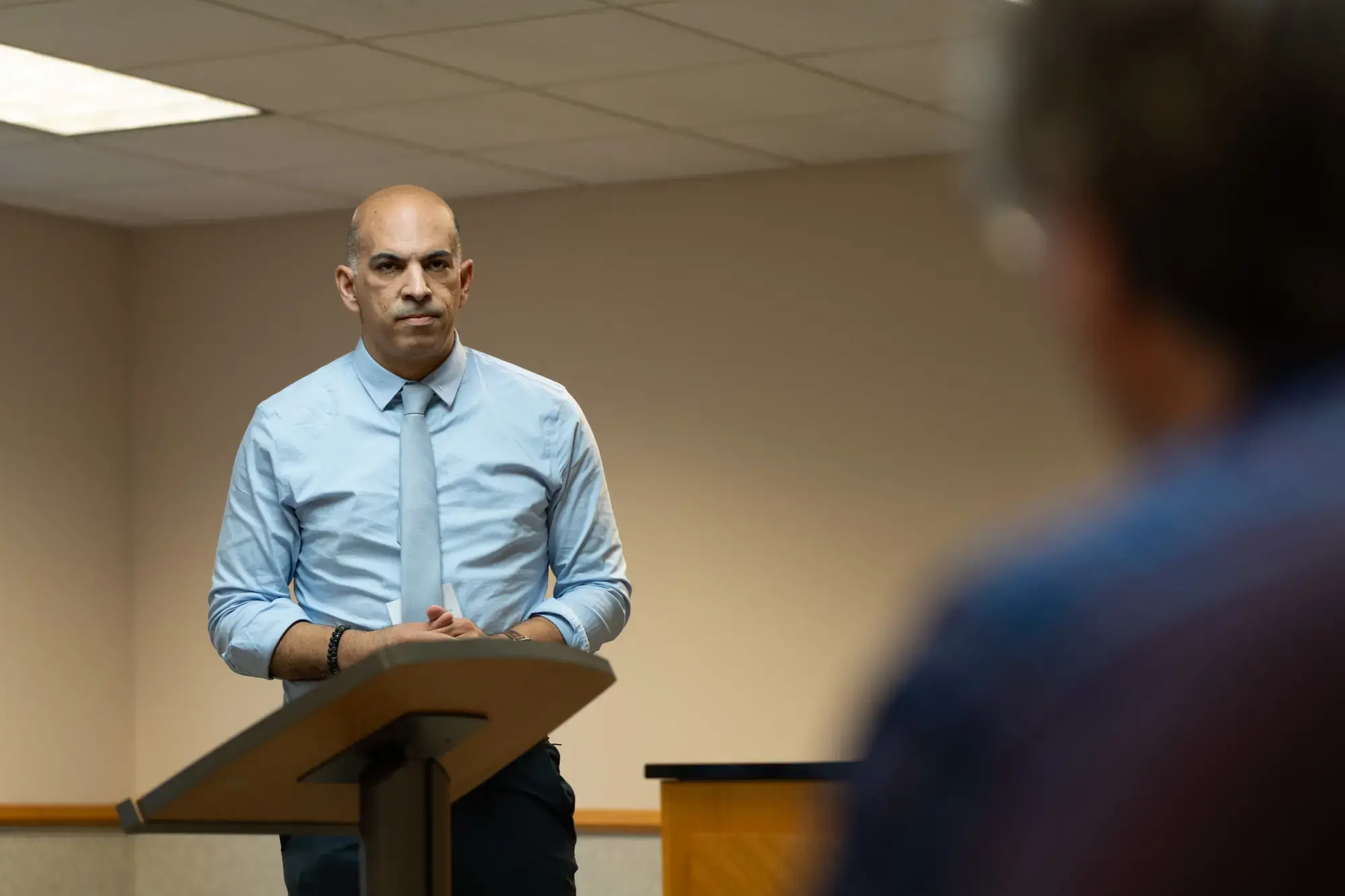
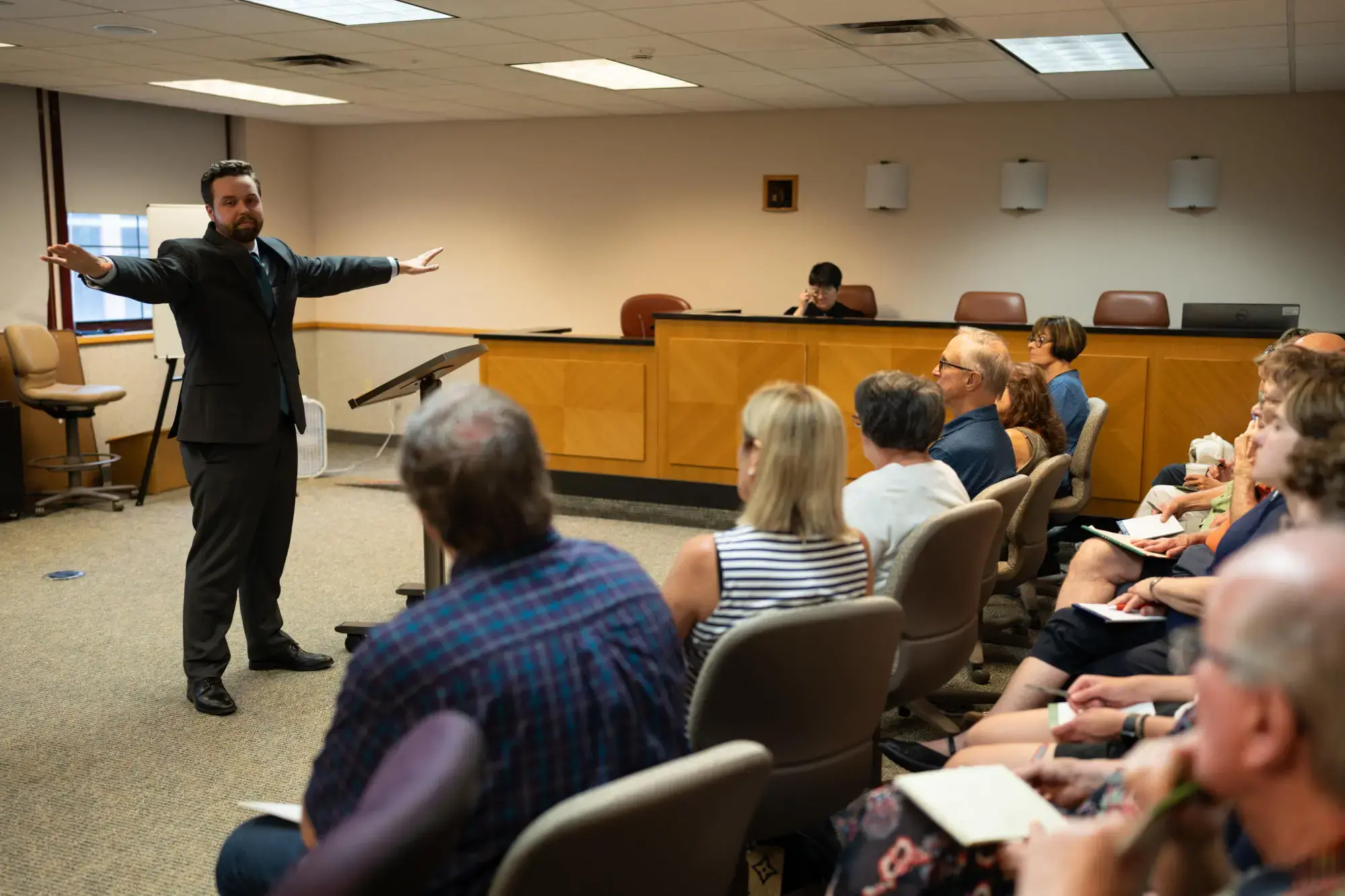
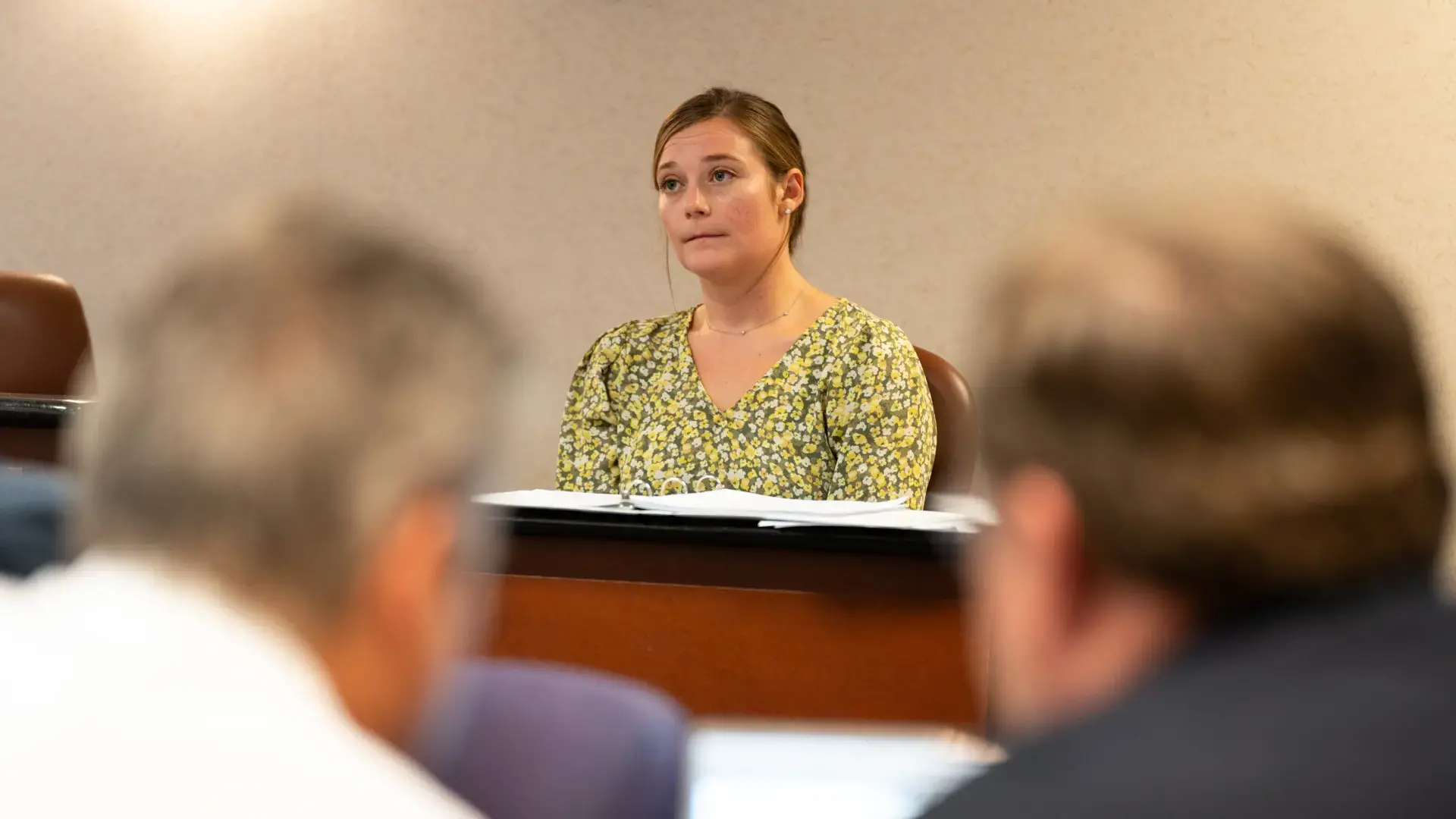
Despite its intended purpose, strictly as a science communication workshop, the law school hypothetical did reflect some of the thorniest issues that have yet to come to a head in real-world cases. And there is a lot of pending litigation.
During one break, Melissa Berke, an organic geochemist at the University of Notre Dame, pulled out her phone to flag an email about a United Nations report on climate litigation, which indexed 2,180 cases (1,522 filed in U.S. jurisdictions alone). For the most part, courts have not delved head-on into the nuances of climate science — and certainly not with an adversarial, back-and-forth battle of the experts. All the decided cases seeking compensation have failed, and so far winning damages seems a bit like the legal equivalent of a snowball’s chance in hell. “Of course it’s been a losing game,” said Friederike Otto, a senior lecturer in climatology at Imperial College London who favors the plaintiffs in climate litigation. “Because it’s the same game that has played out over centuries: It’s very powerful, influential, rich people against the rest of the world.”
But all that, Otto said, is about to change.
Legal scholars anticipate a more consequential role for science, and particularly attribution science, which links climate change to extreme weather, in cases that may go to trial as soon as next year. Plaintiffs are increasingly attempting to hold polluters liable for extreme weather events — or to show that fossil-fuel burning companies knew about the potential harms and lied. In one case, a county in Oregon sued a number of companies over decades of greenhouse gas emissions that caused a 2021 heat dome that killed 69 people. Another suit brought by 16 municipalities in Puerto Rico accuses coal, oil, and gas companies of colluding to downplay the risks of climate-related harms, leading to the intensification of Hurricanes Maria and Irma. And in October 2023, Hawaii’s Supreme Court ruled that a similar suit, claiming harms caused by deceptive behavior, can proceed to trial.
“It’s the same game that has played out over centuries: It’s very powerful, influential, rich people against the rest of the world.”
Friederike Otto, a senior lecturer in climatology at Imperial College London
One currently unrealized problem — and one of the exercises and friction points during the workshop in Minnesota — is the legal framework for admitting experts, particularly those testifying about new or novel scientific fields, and how that dovetails with a broader crisis of junk science. Several groups have questioned whether climate models might flunk the standard for admitting scientific testimony, given the lack of experimental validation and unknown margins of error (two of the factors in the Daubert standard outlined by the U.S. Supreme Court). “There is a lot of theoretical discussion about how Daubert could apply to climate testimony,” Michael Gerrard, founder of the Sabin Center for Climate Change Law at Columbia Law School, wrote in an email, “but the issue actually hasn’t arisen much.”
It did, however, take center stage at the weeklong workshop in St. Paul where, ultimately, Judge Starr determined that all of the scientists playing expert witnesses would testify at trial, and their testimony would be focal in showing whether the flood in the fictional town had been caused by negligence. It would be up to the jury to decide.
Despite her performance earlier in the day, Cook, whose character played a key role in denying the company’s liability, seemed in no mood for losing. She earnestly stressed how the dry run showed just how much scientists needed this sort of training, and then told the opposing team they were about to get creamed: “I really don’t think you guys can win.”
The earliest glimpses of climate change appeared more than a century ago. But arguably the first climate trial — or at least the first one to call expert witnesses — was not decided until 2007. The case, Green Mountain Chrysler Plymouth Dodge Jeep v. Crombie, pitted the automotive industry against the heads of several regulatory agencies in Vermont that had adopted stricter vehicle emission standards.
The industry challenged the admission of testimony from James Hansen, the longtime NASA scientist heralded as the “Paul Revere of global warming,” on the grounds that his opinions arose “out of pure speculation,” but a federal judge ruled that Hansen and two others were qualified. Hansen presented a PowerPoint; the judge upheld the emissions guidelines. (The ruling was ultimately of limited significance; the automotive industry later voluntarily dropped the suit in 2010.)
And that is where the history of climate scientists being challenged in court pretty much started and ended.
Indeed, the short history of climate litigation gives relatively short shrift to climate science. One review in Nature Climate Change suggested that U.S. courts have resisted becoming “a locus for climate decision-making.”
“From the outside looking in, I think the courts are shirking their responsibility,” said Patrick Parenteau, a professor emeritus at Vermont Law School who has ties to Sher Edling, the law firm responsible for most of the climate liability litigation in the U.S. His voice grew animated: “Jesus Christ! This is supposed to be an existential threat we’re talking about.”
Then, in June 2023, Held v. Montana went to trial, the first in a series of youth-led climate cases at the state level to do so. The plaintiffs, aged 5 to 22, claimed the state had violated their constitutional right to a clean environment. Their attorneys called a range of expert witnesses, including an ecologist who explained the science of climate change and its relation to increasingly severe weather and a psychiatrist who spoke about “intergenerational injustices.” The kids prevailed, and the court struck down a state law that prohibited considering emissions when permitting large energy projects.
Despite a consensus that scientific testimony will play a larger role in future climate litigation, should cases get to trial, the outcomes seem anything but pre-ordained. For one, the track record is sparse. There are lots of unknowns. Some legal scholars contend that both pro- and anti-regulatory plaintiffs could lose.
The short history of climate litigation gives relatively short shrift to climate science. One review suggested that U.S. courts have resisted becoming “a locus for climate decision-making.”
Matthew Wickersham, an environmental lawyer in Los Angeles, who works for energy companies, said he expected challenges ahead. In a 2020 paper, Wickersham and two co-authors questioned whether expert testimony would meet the Daubert standard, specifically with regards to a particular actor’s contribution to global warming in a specific region. “Damages are very hard to prove,” he told Undark in a recent interview. Certainly, there is evidence that hurricanes might be more frequent, Wickersham added, “but litigation has to be a lot more concrete than that. It has to be able to show specific causation from a discrete injury caused by a discrete defendant.” (That paper is not alone in pointing out these shortcomings.)
After last summer’s trial in Montana, Gerrard at Columbia University said he found it telling that the defense did so little to challenge the experts. (One of the state’s expert witnesses slated for trial, Judith Curry, a so-called climate heretic for her criticisms of current climate models, dropped out at the last minute; she called the case “nonsensical.”) Contesting the incontrovertible fact that climate change is happening, that it’s getting worse, and that humans are largely responsible, Gerrard said, does not seem like a viable strategy. “That’s going to be very hard to dispute,” he said, citing the Intergovernmental Panel on Climate Change reports, the most comprehensive collection of climate research. “You then get to the second level — whether a particular plaintiff’s injuries are attributable to particular defendants. And there can be more grounds for argument on that. And so I think that’s where the fighting will be.”
There are, of course, issues that have less to do with experts clearing admissibility hurdles or trying to prove a daisy-chain of correlations. (For instance, did a certain company’s actions create a specific percentage of losses and damages, or, as with Held, cause a particular kid’s asthma?) Take the most basic: Was producing and burning fossil fuels the basis for any liability? After all, it was legal, encouraged by governments. Obviously the evidence appeared to be overwhelming, conceded Otto, the Imperial College London climatologist. “But I think what it takes to win is to have judges decide, ‘Yeah, no, actually this is ridiculous, to keep on insisting that it’s fine to burn fossil fuels and it’s not illegal and so there’s no problem.”
Despite a consensus that scientific testimony will play a larger role in future climate litigation, should cases get to trial, the outcomes seem anything but pre-ordained.
In one recent paper, Otto and colleagues suggest a different legal tactic: following the playbook of litigation related to the effects of asbestos on health. In those cases, judges awarded damages despite the scientific uncertainty in proving that victims had cancer only because they were exposed to a harmful substance. As Otto put it: “Judges have said, ‘No, actually this is not really what the law was designed for, but because there is really some injustice that has happened here, we use it that way and give you the right for compensation.”
The prevailing narratives around climate litigation treat lawsuits as an activist-driven blame game, but in Otto’s view, they are really a struggle for justice. This reframing also recognizes that courts double as public spectacle where there is a contest of stories — who gets to tell and share their story, and how those narratives build empathy and sympathy. Climate change remains widely seen as a story about the environment, but it affects people, often those least responsible.
“By burning these fossil fuels, we are violating very basic human rights of a vast part of society,” Otto said. “Obviously the scientific community can’t change that because most of us are very big cowards and don’t talk to anyone but a scientist at all. But I think it’s something that everyone who does climate change communication needs to try and make happen.”
Jim Hilbert, one organizer of the Expert Witness Training Academy, understands what it takes to painstakingly bend the moral arc towards justice. He represented the local branch of the NAACP in a years-long school desegregation case; in subsequent civil rights litigation, the fights took so long, involved so many people, and required so many resources, that he eventually sought the balance that came with a full-time law professorship.
Hilbert, now the interim president and dean at Mitchell Hamline, welcomed everyone on the first day of training and gave the participants their assignments. Later, he made a brief aside: The simulations had run multiple times and proving causation turned out to be nearly impossible. The plaintiffs rarely ever won. Then, Hilbert turned to a screen at the front of the room to introduce David Verardo, who co-created the hypothetical scenario along with Hilbert, Linda Thorstad, the training academy’s program coordinator, and John Sonsteng, who is also on the law school’s faculty. Verardo, who works in Washington, D.C., at the helm of the NSF Paleoclimate Program, appeared by video.
Verardo “demanded” that participants practice role reversals: Scientists, he said, needed to learn how to shape arguments like skilled litigators. As Verardo sees it, the ability of scientists to argue had eroded. Experts asserted things; they showed their evidence. But PowerPoints alone wouldn’t cut it. Scientists needed to be convincing and provide answers — even when there was still uncertainty.
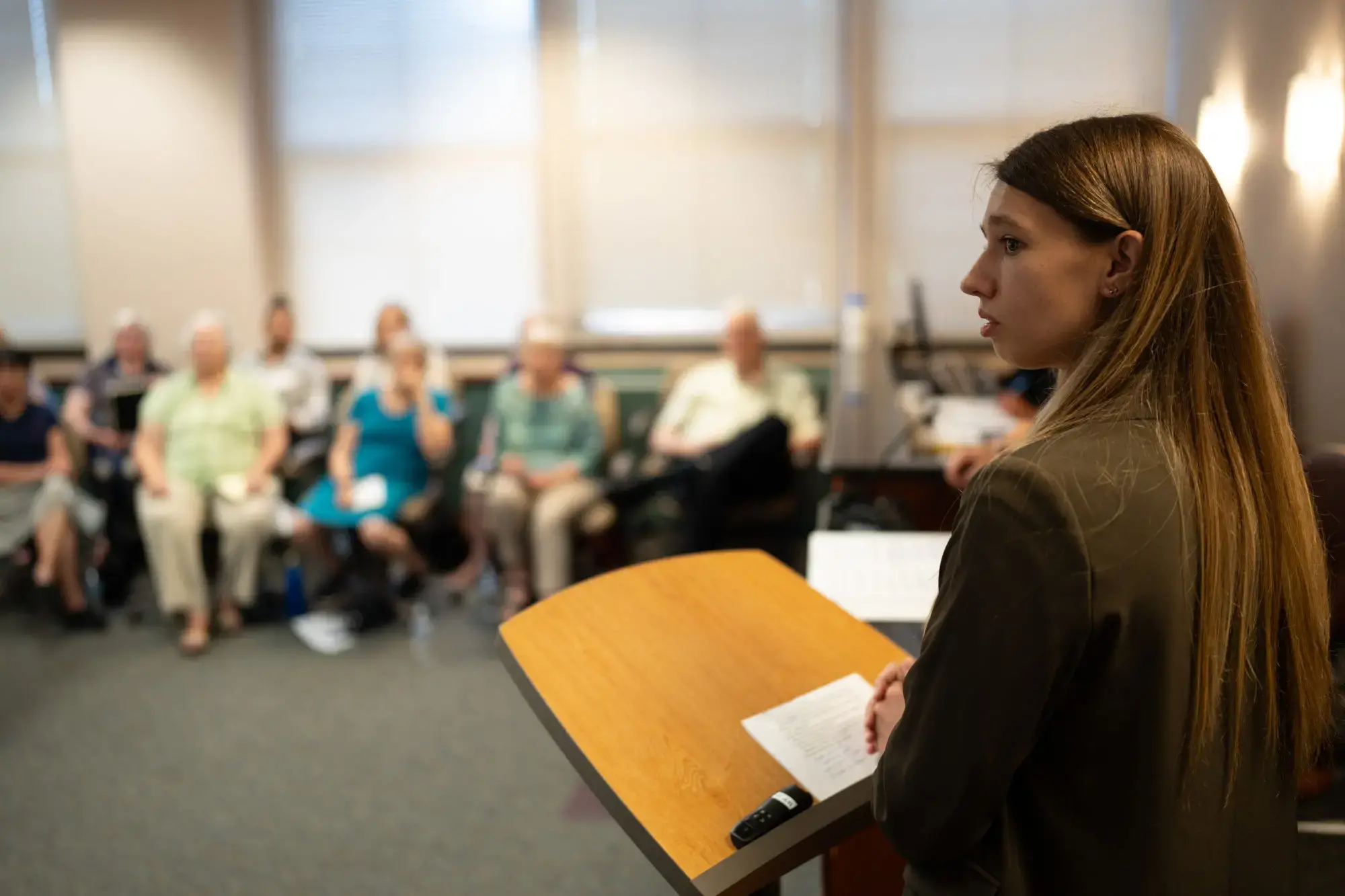
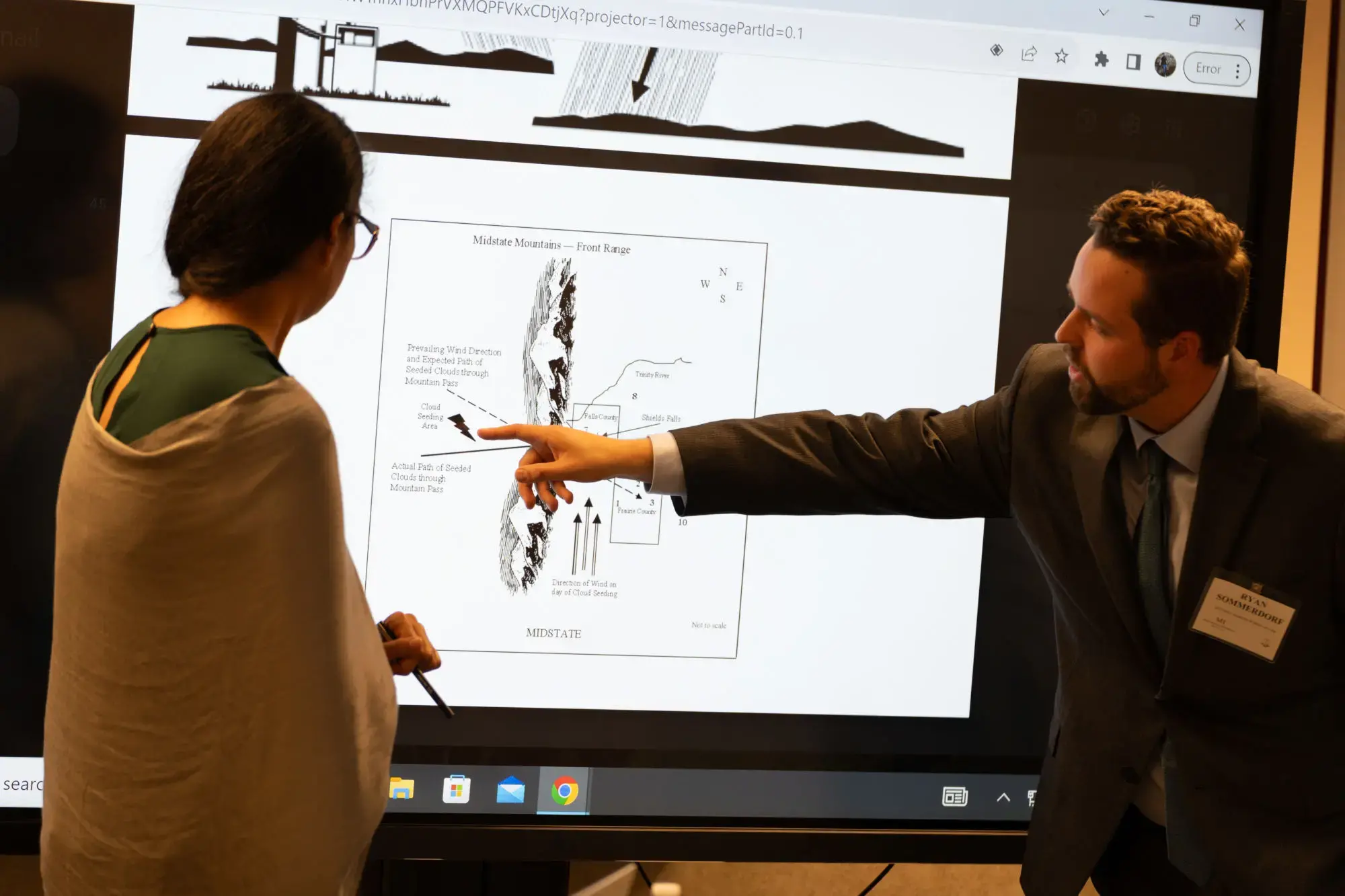
“You just can’t have endless conflict in the law,” Verardo told the group. “So unlike in science, where research is always ongoing and we’re always moving ahead, the law needs some finality.”
That afternoon, Hilbert, who played the part of a boorish politician who mispronounced “causality,” and two colleagues held a mock legislative hearing about the cloud-seeding operation. Maybe it had been a long day. Maybe it seemed too theatrical, as if the scientists had signed up for pipetting and ended up in theater camp. Maybe it was just the inadequate HVAC. But many of the participants looked rather uncomfortable. Which was exactly as Verardo intended. “Participants often cringe when lawyers talk about persuasion,” he said in a phone interview prior to the workshop. “They think that’s manipulative.”
But sure enough, as the week went on, the scientists slipped into character, picking up cues both subtle and dramatic.
One morning, Sarah Ivory, a paleontologist at Penn State who studies ancient pollen, rehearsed her testimony. She explained the average rainfall. Then, a judge asked her to redo with more visual cues. Ivory pointed to her finger: Weather modification ordinarily produced less than a knuckle’s worth of rainfall, she said; in all, the storms during the flood far exceeded her whole finger. It was a tiny gesture, one hinting at the heart of the mock trial and an issue of much larger magnitude — that is, explaining statistical significance to non-scientists at a time when 1.5 degrees Celsius of warming sounds trivial but is a matter of great consequence, potentially affecting the future of humanity.
“All rise."
On day four of the workshop, the law students and the scientists playing expert witnesses stood as 12 mock jurors walked into the room. Two fans whirred. Four scientists playing the role of expert witnesses sat against the back wall. The trial judge, Kathleen Guerin, explained the scenario: Had a cloud-seeding experiment caused rain that, in turn, flooded a town and killed 14 people?
On the stand, several participants dutifully applied the week’s exercises. One tried her hand as an attorney. Another, as an expert witness, paused to dwell on the word “possible,” which was, perhaps surprisingly, a way of expressing certainty. The cloud-seeding had shifted on account of turbulence, another witness said, using vernacular terms to say how her team would never “fly blind.” Finally, the defense called Madelyn Cook, the University of Arizona geochemist and their star witness.
Cook pulled out an easel. She uncapped a black marker and started from square one — drawing the topography around the fictional town, adding clouds and a lightning bolt that signified cloud seeding, and then rain, explaining everything as she went. All the state-of-the-art data, she said as she sketched out the scene, suggested the flood “was very unlikely.” Her presentation lasted nearly 20 minutes, and its objective was clear, arguing that the company’s actions did not meaningfully cause a flood of Biblical proportions: “I think the fact that a 100-year rain, a very low probability event, came, and that winds shifted things, were all unpredictable and not — am I allowed to say? — negligence.”
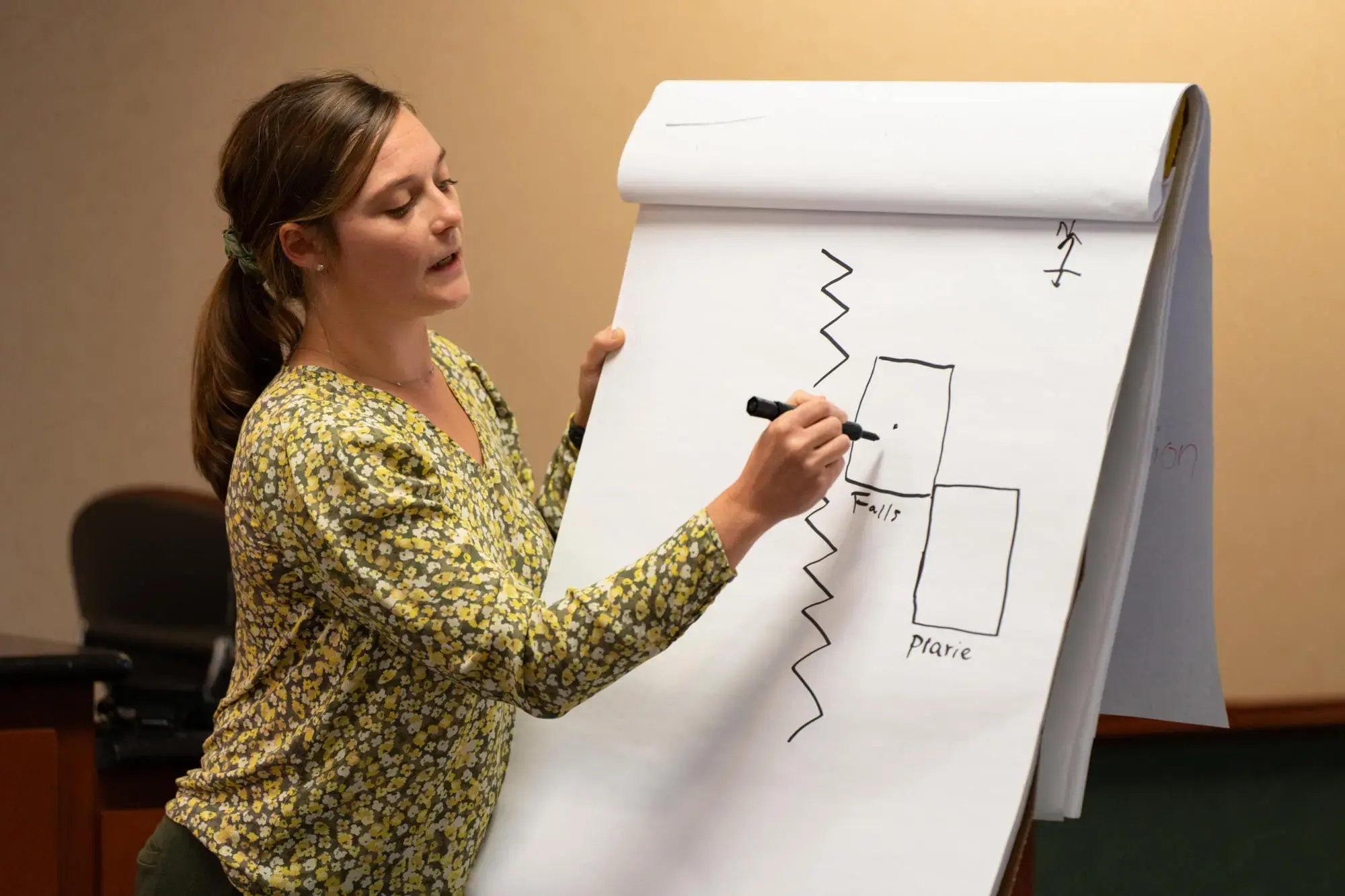

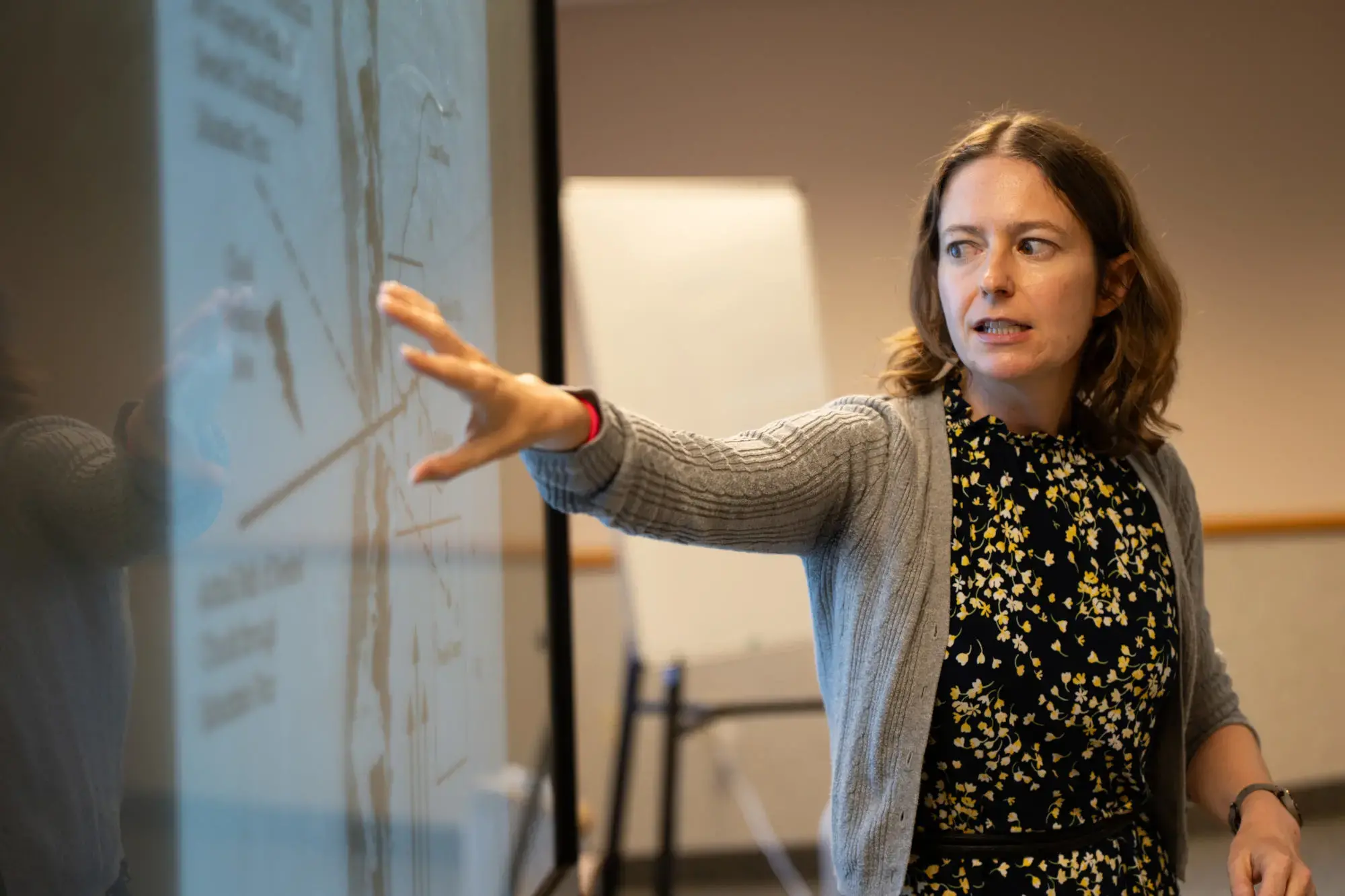
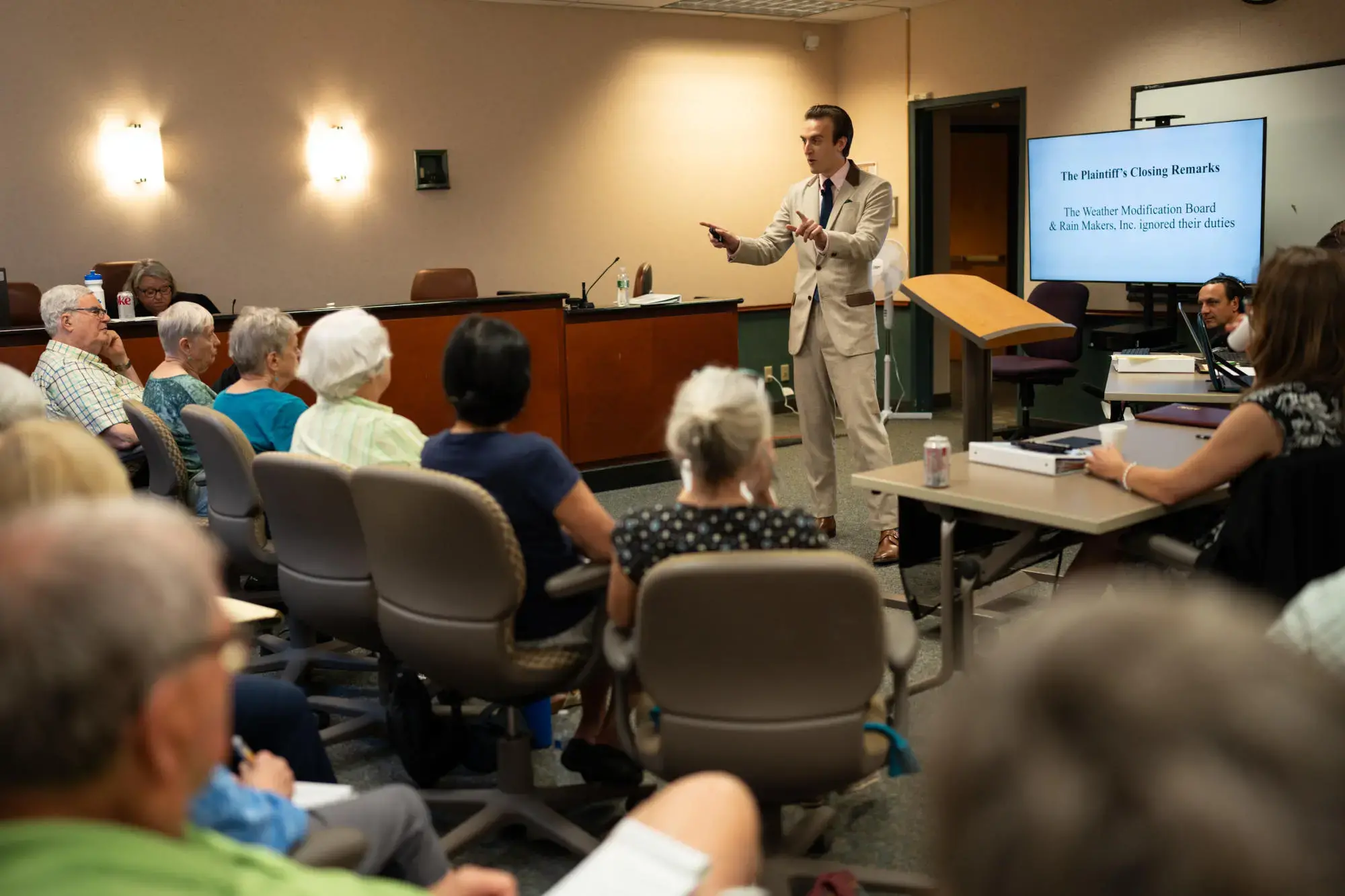
Then, the mock jurors deliberated. In a real courtroom, this happens behind closed doors, but here the volunteers openly discussed what they thought while the law students and scientists from both sides listened in. Initially, the jury was split. Their discussion moved slowly, until suddenly, they all came around to a consensus. The forewoman turned to the judge: “We’ve unanimously decided that nobody was negligent in this case.” No negligence. No damages. It was a decisive win for the fictional company.
Of course, litigating complex concepts such as climate change is not merely some make-believe drama unfolding in a barely air-conditioned theater — and this mock verdict concerned a narrow hypothetical. And yet, at every step of the trial, it seemed, larger questions loomed: What does it take to attribute extreme weather to deliberate human activities? What convinces ordinary people?
These are questions not only for climate scientists and law students, but also for society more broadly. The quest to take action on climate change, in all its weirdness and unpredictability, doubled as a fight for justice, but, as Otto and others framed it, nothing could be won on the science alone. An overwhelming consensus and the mathematical odds were only a couple steps in the path to determining the scope of liability, establishing a moral duty to pay, or even answering whether litigation efficiently addressed the staggering costs of climate change.
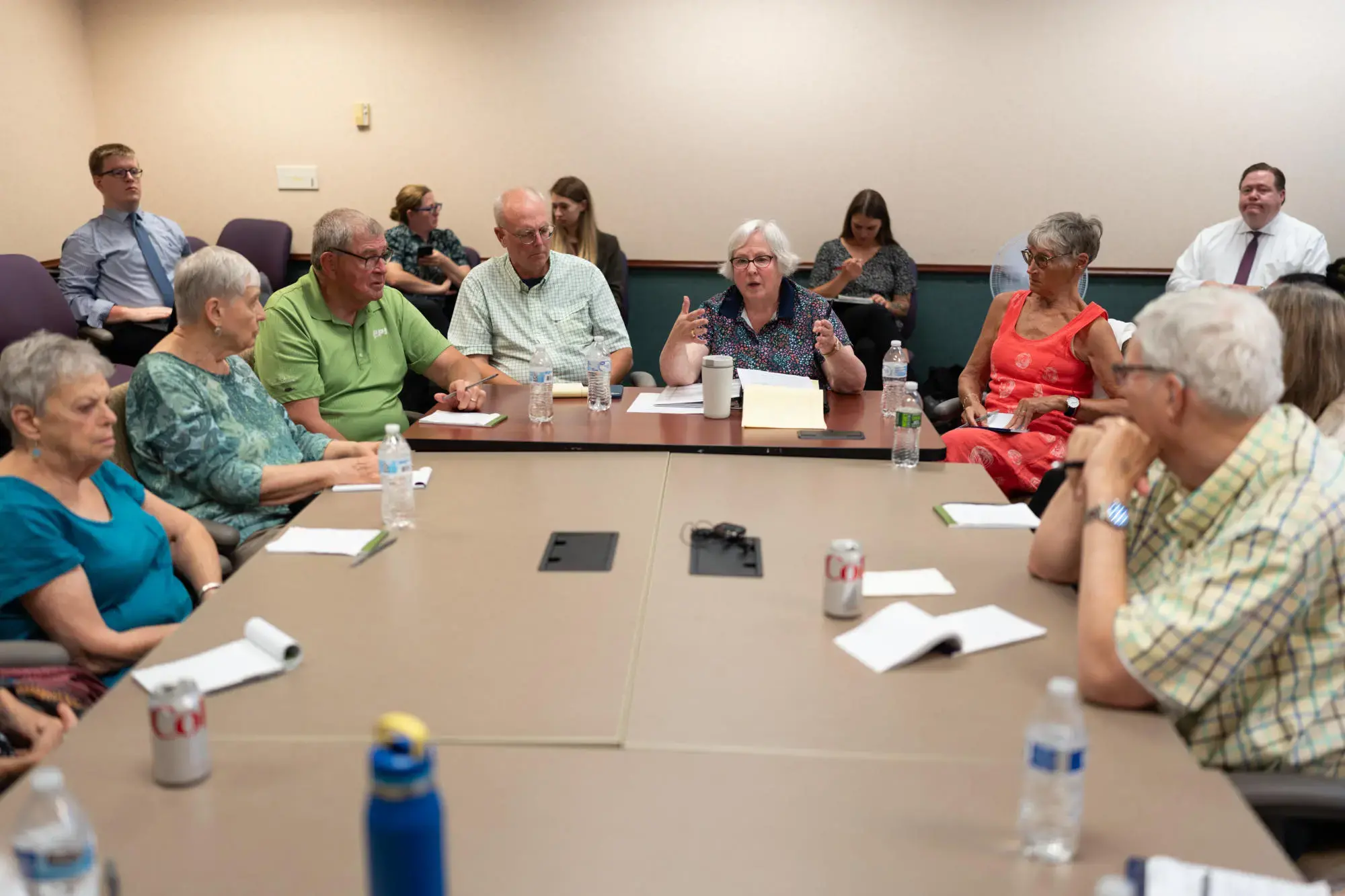
As one program alumnus, Kim Cobb, now director at the Institute at Brown for Environment and Society, asked: “Who pays when there are facts that have been systemically ignored? Who pays when there have been publicity campaigns to misinform the public? Who pays? This is one of the issues of our time.”
After the mock trial, the judge invited the entire cast to sit down with the jurors. What had moved them? The group talked about body language, eye contact, terminology. They did not dwell on facts; they listened to people. One juror attributed her decision to flip directly to Cook’s multimedia drawing. “Showing a static image is a lot to take in, but you did it piece by piece by piece,” she said. The jurors murmured in agreement, and another chimed in to say she finally understood what was going on: “You broke it down.”
For Cook, the workshop reawakened the underlying motives in becoming an earth scientist, which, she said, was “to advocate for something that can’t advocate for itself: the planet.” Now, she plans to go to law school.


